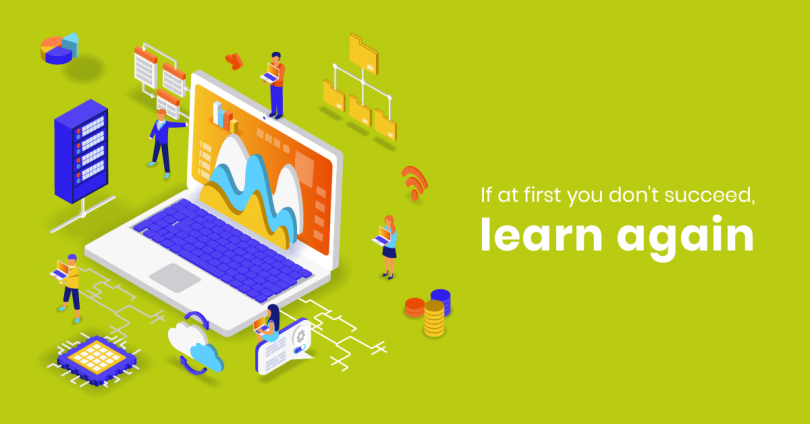In his 1970 book, Future Shock, American Author Alvin Toffler wrote that “The illiterate of the 21st century will not be those who cannot read and write, but those who cannot learn, unlearn, and relearn”. What he was explaining was the learning agility definition. And he was way ahead of his time.
Today, this is a skill in high demand. Put simply, it’s the ability to be in a novel situation, not know what to do, and then figure it out anyway. Individuals who learn the ‘right’ lessons from past experiences are high in learning agility, meaning they’re able to identify the most important info in one situation, and connect it to the right context in a new situation.
Why is this so important to companies? Could it be that they’re dealing with vast amounts of change, and need people who can learn, adapt and solve problems? Yes, that’s probably it. But read on if you’d like to know more before making up your own mind.
What is learning agility, anyway?
This question has been studied by brilliant minds for some time now. Researchers have been on a quest to define the skills and characteristics that an agile learner might display. You know, what does an agile learner do?
What they’ve discovered is that the learning agile among us know what to do in situations of uncertainty. They connect information from past and present experiences in a way that helps them make sense of the world, even when it’s changing. And, perhaps most importantly, they’re comfortable with being uncomfortable.
To further define learning agility, Dr. W. Warner Burke of the Teachers College at Columbia University, broke it down into 9 dimensions: Flexibility (open to new ideas and solutions), Speed (acting quickly), Experimenting (trying new behaviors), Performance Risk-taking (taking on novel challenges), Interpersonal Risk-taking (discussing differences in opinions), Collaborating, Information Gathering, Feedback Seeking and Reflecting.
If you’d like to find out how to cultivate the sort of teams that display these dimensions, this next part is for you.
How can learning agility be improved?
Imagine that you’re being promoted from a Learning Designer to a Learning Design Manager (yay!) Or maybe you’re moving over to another career path entirely, let’s say, a Learning Technologist. How do you know that you’ll be good at your new job? Short answer: you don’t!
So, you’ll need to be able to think on your feet and make the best in-the-moment decisions to perform well in unfamiliar situations. You’ll need to be an agile learner. But hang on! Isn’t that something that’s hardwired into a few lucky people from the get-go? Sure. The behavioral components of learning agility, though, can be learned. Here’s how.
Find the gap using learning agility assessments
The hard truth is that not everyone is born an agile learner. In fact, many people don’t ever become agile learners. But it’s different for each person. So, while the competencies of learning agility can be taught, you first need to know which of those competencies are missing in the first place.
Your most treasured tool for doing this will be assessments. There’s more than one to choose from. Perhaps the most popular is this assessment by Mettl, or this one by Korn Ferry. But whichever you choose, it’s important that employees understand what they’re being assessed on, and why.
So, provide employees with training on the 9 dimensions described earlier. This should include learning agility examples to help them recognize the behaviors that agile learners display. Then, once they’ve completed the self-assessment, they’ll understand what they haven’t been doing, and should start doing, in order to improve.
Celebrate mistakes as learning opportunities
Three of the dimensions of learning agility depend on openness to being, well, wrong. These are Information Gathering, Feedback Seeking and Reflecting. But being wrong hurts. And if mistakes are considered taboo, employees will develop a natural defensiveness when things don’t go as planned. And they won’t be looking for information to confirm it!
But the fact is, unless you’re Chuck Norris, completing a task perfectly the first time around is unlikely for most people. And agile learners, being excited about new challenges and comfortable with risk, are probably going to make mistakes. But, they’ll also fail fast and learn how to perform better next time.
So, rather than smoothing out the rough edges of your existing agile learners, create an environment that’ll let more agile learners come to shine. A place where mistakes are seen as learning opportunities. Where risks are encouraged, and defensiveness is unnecessary.
One way to do this is by recognizing and rewarding learning agile behaviors. Offer monetary incentives and social recognition for employees who learn from their errors. This public demonstration will show the rest of the company that taking risks and learning on the fly is not only accepted, but appreciated.

Foster a culture that challenges the status quo
Agile learners are confident enough to challenge the status quo, and they take interpersonal risks when their opinions differ from someone else’s. They don’t just accept arguments at face value. They evaluate them, look for inconsistencies, ask questions and make suggestions until they fully understand and agree with a point of view.
But this ‘rebellious’ streak isn’t easy to find in most companies today. Because employees feel bound by their status, and are scared to disagree with others lest they disturb the office utopia. Of course, this is especially true when the person they disagree with is senior to them. Nobody crosses the boss!
But you can change this in your own workplace culture by actively inviting your team to ask questions, present their ideas and suggestions, and offer alternatives. When employees voice their opinions, and this leads to a better solution or outcome for the team, reward them. This will encourage them (and others) to practice the behavior again in the future.
Equip employees with the skills to deal with uncertainty
To be truly learning agile, employees need to be comfortable with unfamiliar situations. They need to be okay with not knowing what to do in those situations. And they need to be calm, confident and logical in their approach to solving problems. This requires a mental shift, where experimentation and uncertainty become an exciting, not a fearful, part of work.
The best way to do this is to immerse employees in parts of the job or company that they haven’t experienced before. In other words, throw them in the deep end of wild, unchartered waters and let them figure out how to stay afloat. You can do this by enrolling employees on practical training programs that include job shadowing, job rotation, and temporary assignments.
Then, throw them a lifejacket. As they embark on these new experiences, offer online courses that teach them how to take a systematic, rational, and logical approach to problem-solving. This way, they’ll learn the skills they need to deal with uncertainty, and they’ll be able to practice them in real situations.
Conclusion
Today, employees will become incompetent in their current jobs if they don’t grow, adapt, and evolve to changing technologies and processes. And their employers, well, they’ll go down with them. So, skills like learning agility are fast becoming the secret to success in the 21st-century workplace.
Want to know who agrees? Laszlo Bock, former SVP of People Operations at Google. In a recent interview with Thomas Friedman for the New York Times, he shared: “For every job, the No. 1 thing we look for is general cognitive ability, and it’s not I.Q. It’s learning ability. It’s the ability to process on the fly. It’s the ability to pull together disparate bits of information”.





